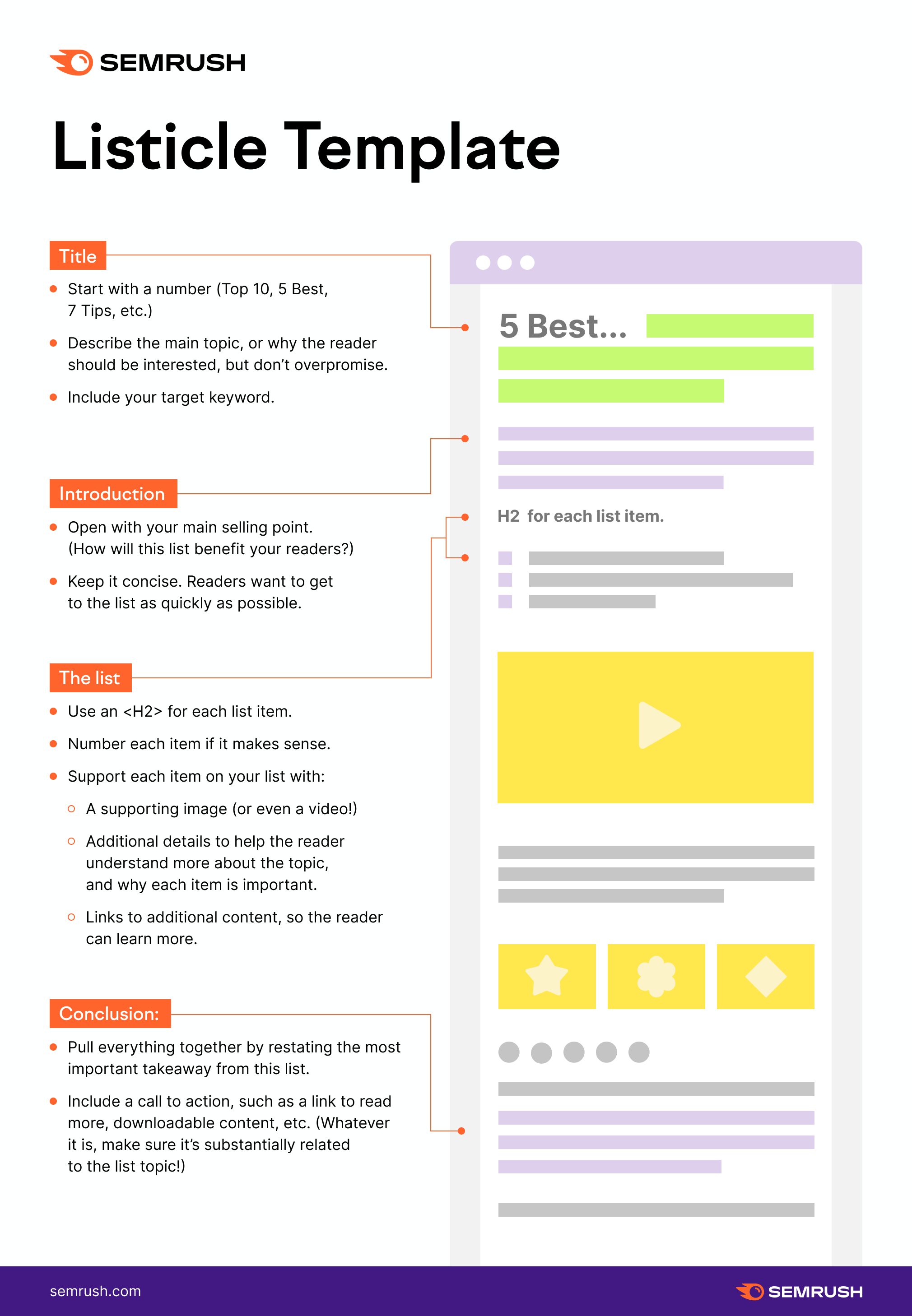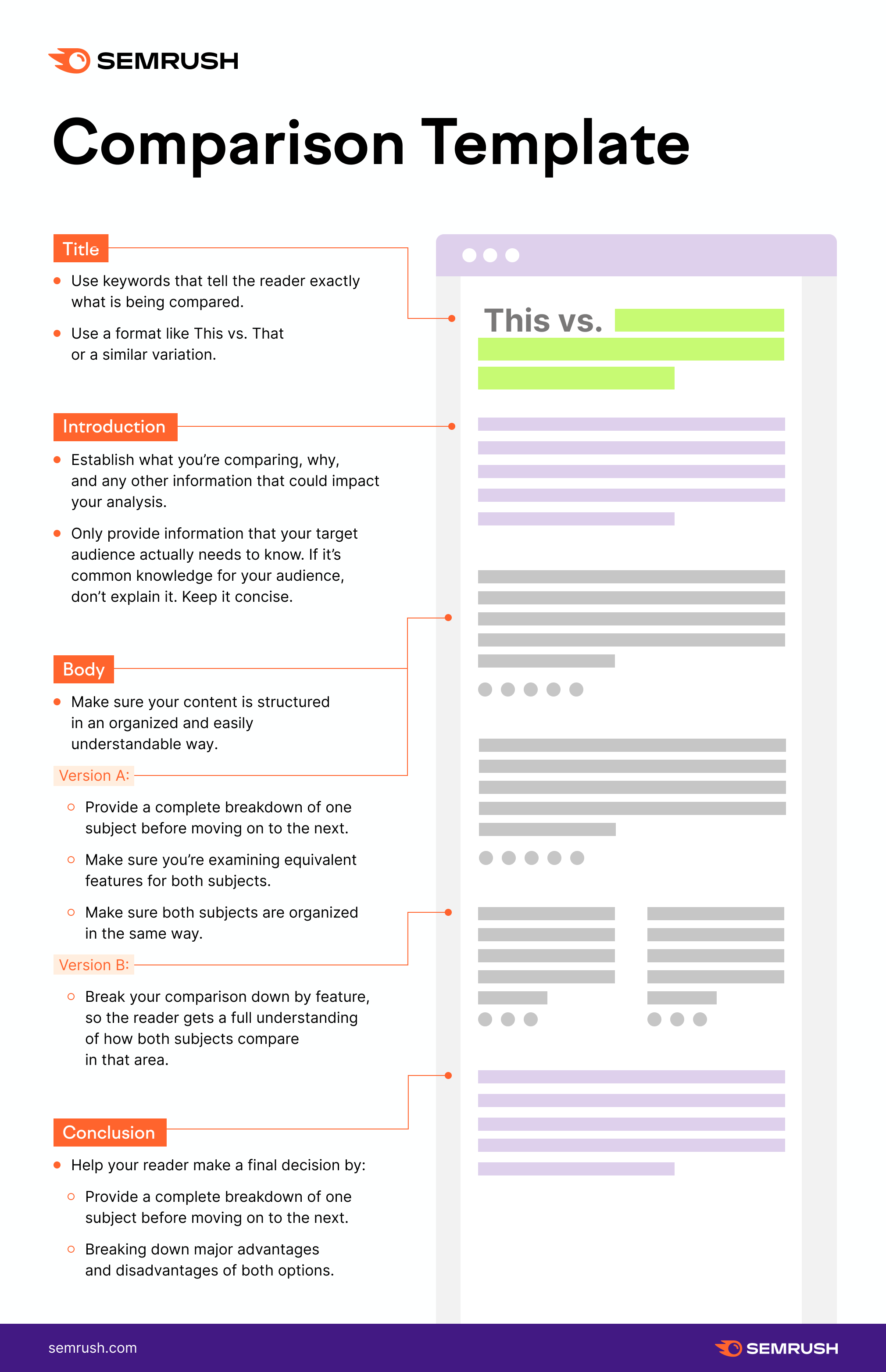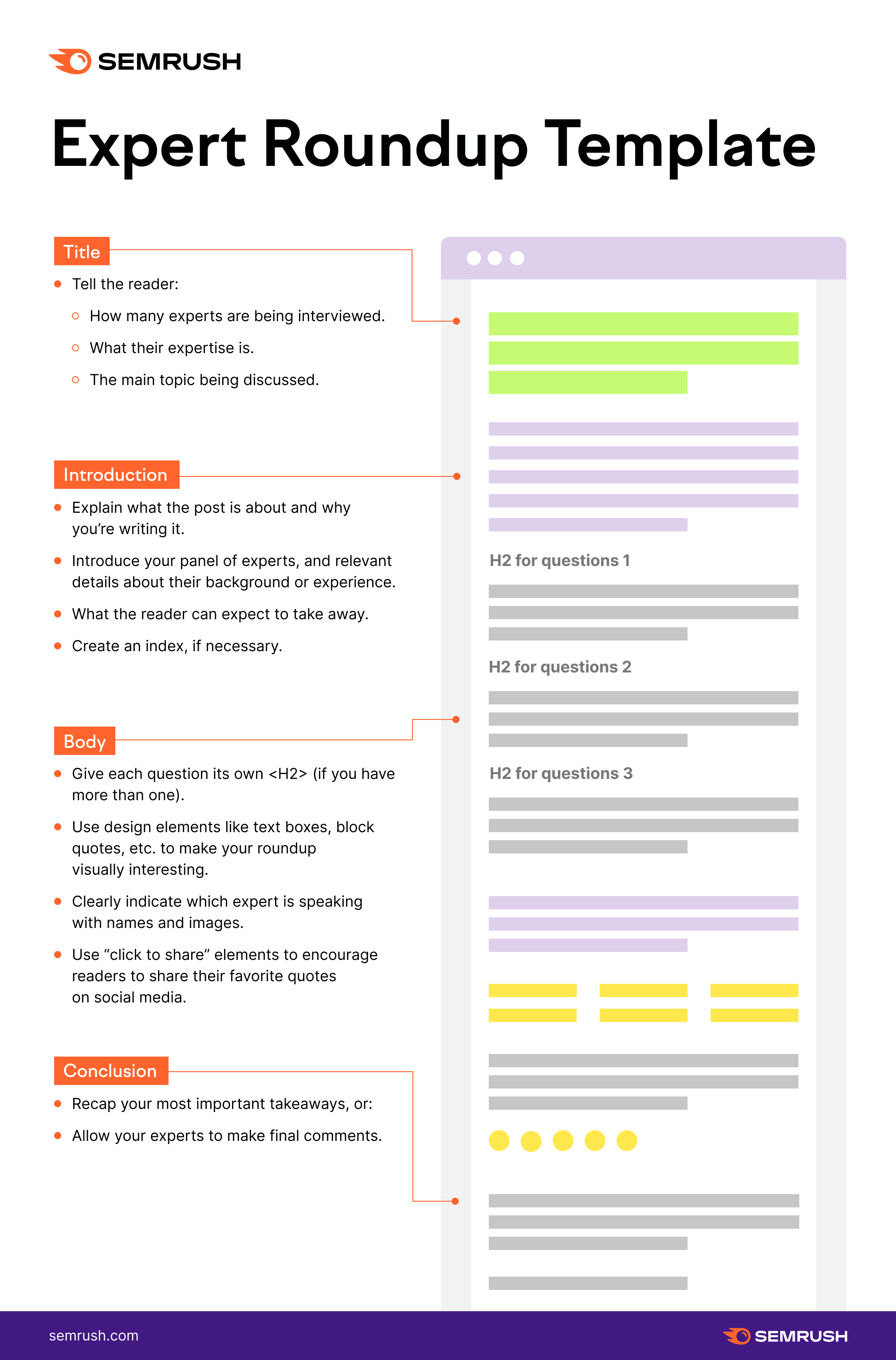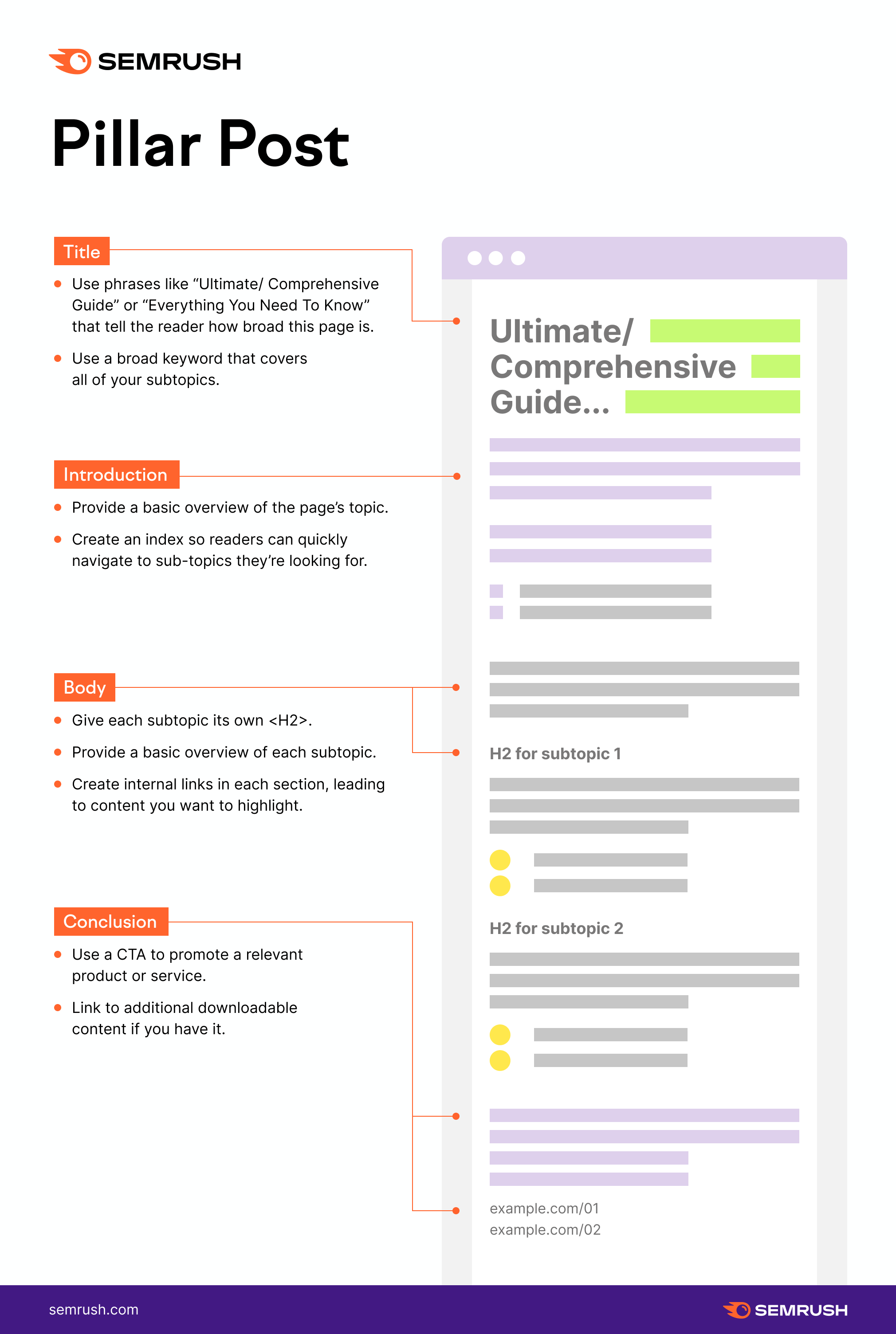A good blog post template helps you brainstorm, focus your planning and research, and write effective SEO content quicker and easier. Below are five free blog post templates for you to use, plus details about using them effectively. Feel free to download them, bookmark them, and adapt them to your audience’s (and your writers’) needs.
Listicle Content Template
A listicle (a portmanteau of “list-article”) is a blog post or article formatted like a list. Typically, each point on the list gets its own numbered header, supported by images and other content. (If you were on the internet in the mid-2000s, think back to all those Buzzfeed articles you probably read.)
Benefits of listicles:
Easy to read and understand quickly Engaging and addicting to read Easy to share, promote, and repurposeIf you’re unsure if your blog post topic is list-friendly, try describing it in one sentence.
For example, this article is about five different blog post templates useful for content marketers. It’s clear from that description (five different things that all support one central message or idea) that this topic could become a listicle.

Listicle Title
The perfect listicle title is attention-grabbing but NOT clickbait. A title is clickbait if it is overly emotional or shocking in a way that doesn’t reflect the content. To avoid this, make sure you only use titles that accurately reflect your article as a whole.
Listicles are often satisfying to read because they deliver on an implicit promise made in the title.
Consider, for example, this TechRadar article:

This title is effective because it tells you how long the list is, why you’d want to read it, and it targets a super-relevant, high-volume keyword. Use a similar strategy when coming up with your title.
Tips for choosing your listicle title:
Start with a number, telling the reader how many items are on this list. Clearly describe the main topic of your listicle without overpromising. Include your target keyword.Listicle Introduction
A practical listicle introduction should do two things:
Establish the main selling point of your listicle (why should readers care?) Get in and out as quickly as possible.Readers love listicles in part because they’re easy to read quickly (or they feel that way). Your introduction should feel the same way. Give your readers the essential information, and then move on.
Listicle Body Copy
Before you write your body copy, start by listing each item you want to include. This list should:
Have the same number of items as promised in the title. Consistently relate to your main topic.Once you’re happy with your list, each item can become an <H2>. Ideally, you’ll number each header. Numbers help readers keep track of their progress through the article and entices them to finish reading.
Bonus tip: Headers aren’t the only way you can recycle your outline. Once it’s polished, you can also use it to create a super shareable infographic to promote your post.
Once you’ve laid out your list headers, build out each section with:
A supporting image (an illustration, photo, infographic, or even a video could work here) Essential details about each item Links to additional content if they want to learn more.Include all the best, most relevant, and most exciting information for each section, but make sure each section of your list is only as long as it needs to be, not longer.
Listicle Conclusion
Use your conclusion to highlight the reader’s main takeaway from this list. Try to include a relevant call to action (CTA) here as well. You could promote a related product or service, encourage readers to download additional content, or link to other related articles.
How-To Blog Post Template
How-to blog posts are instructional articles that guide the reader through a specific process or workflow. Because you’ll also number these processes, how-to posts can look similar to listicles. They can help you establish authority in your specialty area and build trust with readers, so the more helpful and reliable you are, the better.
To determine if your blog topic should be a how-to article, ask yourself these questions:
Am I describing a process made up of multiple steps? Do all those steps have to be completed in order? If the reader follows this process, will they achieve a specific goal or solve a particular problem?If the answer to any of those questions is “no,” then reconsider whether you should be writing a list post instead.

How-To Blog Post Title
For how-to articles, the best titles are straightforward. For inspiration, think about the types of search terms you use when trying to solve a problem. You probably open Google and enter a phrase like “how to recover deleted files on a PC.”
Tips for writing a how-to article title:
Start your title with “How To” Use simple, direct language with active verbs Tell the reader exactly what problem they will solveFor more title inspiration, use a tool like Keyword Magic, which allows you to filter on question words like “how” and even displays featured snippet opportunities.
How-To Article Introduction
In your how-to post introduction, your main goal is to establish that you understand the problem you’re trying to solve and propose your solution. Remember, you’re only giving a broad overview here. You’ll go into more detail throughout the post.
If you have evidence that your process works — for example, a statistic showing how effective it is — include that here to build credibility.
How-To Blog Post Body
Start by outlining the basic steps your how-to guide needs to include. Each item on this outline will become a <H2> for your article, so make sure that you:
Number each step. Use active verbs to describe each step. Include supporting keywords where appropriate.Once you’ve created your headers, it’s time to flesh them out with crucial supporting information. Here’s some of the information you might need to include:
An illustration or infographic depicting the process A list of instructions on how to complete this step Details about what, specifically, you’re trying to accomplish and why Additional resources, necessary skills or materials, or other vital informationHow-To Article Conclusion
You have a few options when concluding your how-to post. For example, you could suggest a few next steps for your reader. You could also tell them where to learn more, especially if they might have additional material (such as another how-to post). If you have a relevant product or service, consider mentioning it here as your call to action.
Comparison Article Template
Often used to compare similar products or services, comparison articles help readers to differentiate between products or ideas and — more importantly — help them settle on a decision. In other words, they’re perfect for targeting readers who are reaching the end of their buyer’s journey and are almost ready to make a purchase.
An effective comparison article:
Compares equivalent features Makes concrete observations that you can back up with evidence. Avoids bias.
Comparison Blog Post Title
When you’re ready to title your blog post, start with a keyword research tool like Keyword Magic. Enter a keyword that aligns with your comparison article topic (e.g., Subject A. vs. Subject B) and use the strongest version in your H1. If you’re comparing more than two things, adapt your title accordingly.
Once you’ve identified the right keyword to target, you can flesh it out with additional details or even add a supporting keyword if it makes sense.
Comparison Blog Post Introduction
When you’re writing your introduction, think about the specific reader you’re targeting. If they’re looking to compare two products, they most likely already have basic knowledge about the topic. So you don’t need to waste your time (or theirs) defining basic terms or providing background information they already know.
Instead, focus on establishing what you’re comparing, why, and other essential details that could impact your analysis.
Comparison Post Body
Before you start writing your body copy, it’s critical to decide how you will structure it. How you organize your comparison post can enormously impact your readers’ and search engines’ understanding of the content.
Make sure your comparison post is:
Organized (so that readers and search engines can easily understand it) Scannable (so that readers can quickly find the information they need) Consistent (so that readers can easily compare equivalent features)Here’s one example of how to structure a comparison article:
Subject A Feature 1 Feature 2 Feature 3 Subject B Feature 1 Equivalent Feature 2 Equivalent Feature 3 EquivalentIn this example, the reader can understand one subject entirely before moving on to the next. Note that both sections are organized similarly, making it easy for the reader to understand and choose.
Here’s another structure you can use:
Feature 1 Subject A Details Subject B Details Feature 2 Subject A Details Subject B Details Feature 3 Subject A Details Subject B DetailsIn this case, the article emphasizes the features over the actual subjects. As a result, the reader gets a more direct side-by-side comparison.
Either of these structures could be effective for you. Choose the one that feels more natural for you and aligns with the message you want to send, the information you have, the keywords you want to target.
Comparison Blog Post Conclusion
Wrapping up a comparison article generally involves coming to some kind of conclusion. Which subject reigns superior — or how can the reader make that choice for themselves? Here, you can quickly sum up each choice’s significant advantages and disadvantages and help guide the reader to a good decision.
The Expert Roundup Template
Need to boost your brand with influencers, encourage social shares, and write great blog content that requires comparatively less writing? Consider the Expert Roundup.
The Expert roundup is a hybrid of an interview and a listicle, designed to offer readers a ton of information from various sources. And best of all, those sources you interview might share your post with their followers, increasing your visibility.

Before You Write
Expert roundup posts require more prep and outreach before writing, so make sure you give yourself extra time. Consider how much time you’ll need if you plan to work with external thought-leaders and influencers in your space instead of sources within your organization.
You’ll also need to prepare your questions in advance. How many you’ll need depends on a few factors, such as:
How many experts you’re interviewing. The depth of the responses you get The focus subjectTo be safe, consider over-preparing with a few additional questions. That way, you can extend your interview or swap a few questions out as needed.
Expert Roundup Article Title
An ideal title for your expert roundup blog post needs to tell the reader three things:
The number of experts featured. Their area of expertise. The main topic these experts are discussing. (This is a good opportunity to use your target keyword.)Consider this example from Influencive, posted in January 2021:

Before reading the rest of the article, we already know what to expect: 17 people with marketing expertise will tell us what they think the marketing landscape will look like in 2021. Readers can anticipate that this post probably discusses marketing trends to watch out for or potential challenges marketers can expect in the upcoming months.
By using a similar approach for your title, you can target readers with an active interest in learning more about your selected topic.
Expert Roundup Introduction
In your introduction, expand on the essential information you shared in your title. Specifically, make sure you communicate to the reader:
What this post is about, and why you’re writing it Who you interviewed, and their expertise What the reader can expect to take awayIf your roundup post is lengthy, consider adding an index here so that readers can skip straight to the questions they’re most interested in reading.
Expert Roundup Post Body
Once you conduct and transcribe your interview, most of the writing is complete. The next step is to lay it all out. It should look something like this:
Question #1 Expert #1: Their answer. Expert #2: Their response. Expert #3: Their response. Question #2 Expert #1: Their response. Expert #2: Their response. Expert #3: Their response.Feel free to lean into your creativity with the design. You can use block quotes, text boxes, and other design elements to make your post more visually engaging while still being easily readable.
For example, you might display the interviewee’s photo beside each answer or color code the text boxes by individual. You can also include information like their Twitter handle or their title, if appropriate.
You could even add click-to-share buttons, making it easier for readers to post their favorite quotes from your roundup on social media.
Expert Roundup Blog Post Conclusion
Wrap your interview up with a short recap of the most important takeaways. Or ask each interviewee for closing remarks, and allow each expert one final moment to shine.
Either way, don’t forget to include a call to action. If you’ve collaborated with these experts in the past for other interviews, ebooks, or webinars, it might be a good idea to call those out here.
The Pillar Post Template
A pillar post, sometimes called a content hub or a hub page, acts as a central overview of a broad topic, with links to more detailed and specific content.
Pillar posts help you establish authority in a specific area and help readers find more of the content they’re looking for on your website. Read this post on the Semrush blog for more examples of particular types of pillar pages if you want to learn more.
Here, we’ll go over a fundamental pillar post structure, which you can adapt and change according to your needs.

Pillar Blog Post Title
Pillar pages are broad by nature. As such, their titles usually have language that tells the reader how comprehensive they are.
For example, you could use phrases like “Ultimate Guide,” “Comprehensive Guide,” or “Everything You Need To Know About [Your Topic].” Your target keyword should also be reasonably broad because it needs to cover all of the more specific sub-topics you’ll be including.
Pillar Post Introduction
In your intro, provide a basic overview of the broadest version of your page topic. For example, if you’re writing a pillar post about SEO, you might want to explain on an elementary level what SEO is.
Because this is likely to be quite a long page and one likely to grow over time, consider creating an index here with anchor links to each subtopic you’ll be covering.
Pillar Post Body
First, create an <H2> for each sub-topic. For example, if your pillar page is about SEO, you might have a section for technical SEO, content writing and management, paid search, and competitive analysis.
Each section should include a basic overview of that sub-topic and what kind of content you have to offer.
Then create your internal links. How you do this depends on how your site is structured. One idea is to create a small index in each section, linking directly to the specific pieces of content you want to highlight. If you already have other pillar pages for each subtopic, you could also link to those.
Pillar Post Conclusion
As with your introduction, you can keep your conclusion short and sweet. If you have a product or service that this pillar page supports or relevant downloadable content, you can direct the reader to it with a call to action.
Create Great Content Without Headaches
Whichever template you choose, you first need to identify the basic message you want to send. (If you’re not sure where to start, try entering one of your target keywords into the Topic Research tool to get some ideas.) Your overall message should be something that:
Pertains to your target audience’s interests Has a relationship (even indirect) to your area of expertise Enables you to show your audience your unique perspectiveContent creation doesn’t have to be a headache. Using the right tools and a well-crafted blog article template, you can quickly hone your writing process and create more compelling content.
Innovative SEO services
SEO is a patience game; no secret there. We`ll work with you to develop a Search strategy focused on producing increased traffic rankings in as early as 3-months.
A proven Allinclusive. SEO services for measuring, executing, and optimizing for Search Engine success. We say what we do and do what we say.
Our company as Semrush Agency Partner has designed a search engine optimization service that is both ethical and result-driven. We use the latest tools, strategies, and trends to help you move up in the search engines for the right keywords to get noticed by the right audience.
Today, you can schedule a Discovery call with us about your company needs.
Source:





